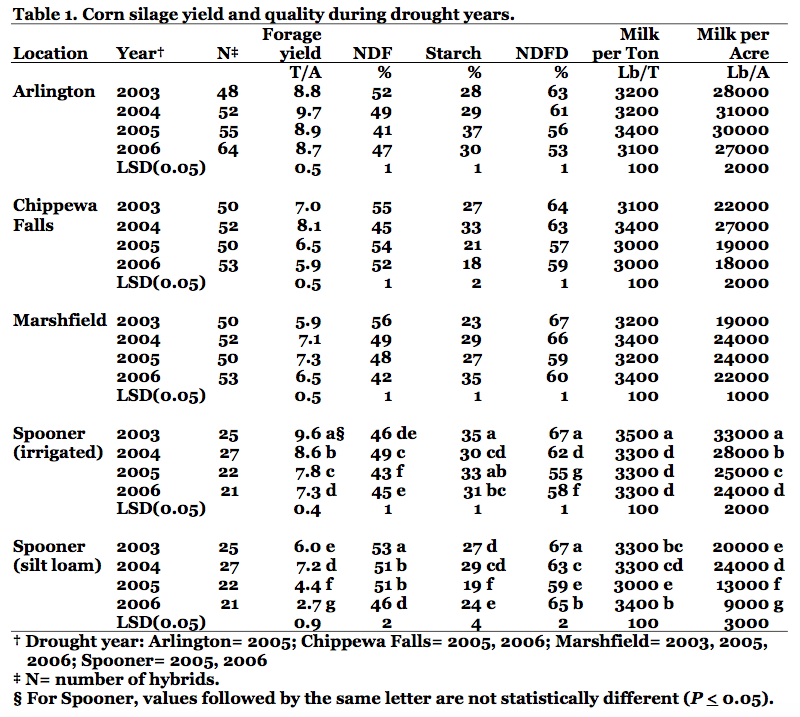Farmers trying to decide about using drought affected corn fields must first determine success of pollination. If pollination will affect grain yield, then growers must follow directions given by hail adjusters to ensure insurance payment. If the decision is made to harvest the field for silage, then it must be cut at the proper moisture; the crop is usually wetter than it appears.
Yield of drought affected fields is usually reduced. But buyers and sellers of corn silage often ask, “How does drought affect corn silage quality?” Sellers look at drought affected corn and either are disappointed and just try to get what they can for the field, or give up, plow it down, and start planning for next year. Buyers look at a drought affected corn field and wonder how well cattle can produce milk or beef from the silage and what additional feed supplements will be necessary for the feed ration.
The objective of this paper is to evaluate silage yield and quality in environments affected by drought. Data collected between 2003 and 2006 from the University of Wisconsin hybrid evaluation program was used with random hybrids.
Environments with drought stress prior to pollination
Two environments (Arlington-2005 and Marshfield-2006) had drought stress prior to pollination, followed by timely rains during pollination and grain-fill. Plants in these environments were short (i.e. < 6 feet tall), but had average to above average grain yield for the location. Forage yield tended to be reduced slightly in these drought affected environments compared to normal environments. For example at Arlington during 2005, forage yield of 55 hybrids was 8.9 T/A while 2003, 2004, and 2006 forage yield averaged 9.1 T/A (Table 1, below). NDF content was lower and starch content was greater resulting in higher than average Milk per Ton. Corn plants were shorter but had a greater proportion of grain in the silage. Thus, quality as measured by Milk per Ton was not affected, and yield as measured by Milk per Acre and forage yield was similar to other environments.
Environments with drought stress extending into grain filling
Environments that had drought stress extending into grain filling were Chippewa Falls-2005,2006, Marshfield-2003, 2005, and Spooner-2005, 2006. At Spooner the same hybrids were planted on a dry land silt loam site and under a site with center pivot irrigation. We will consider the Marshfield environments separately.
Drought stressed environments extending into grain filling had 18 to 46% lower forage yield than normal environments (drought v. normal environments: Chippewa Falls= 6.2 v. 7.6 T/A= 18%; Spooner silt loam= 3.6 v. 6.6 T/A= 46%). Usually starch content was reduced. Silage quality, as measured by Milk per Ton, was reduced 3 to 8% in drought stressed environments (Chippewa Falls= 8%; Spooner silt loam= 3%). Milk per Acre was reduced 24 to 50% in drought stressed environments (Chippewa Falls= 24%; Spooner silt loam= 50%).The Spooner irrigated site followed similar trends although the magnitude of the difference between drought stressed and normal environments was not as great.
At Marshfield, growing season environments from April 1st to August 15th during 2003-2006 have been extreme for temperature or precipitation. During 2003, the growing season was both cooler and drier than normal. During 2004, precipitation was normal, but it was the coolest of the previous 30 years. During 2005 and 2006, temperature was normal, but precipitation was lower than normal; although 2006 ended with average grain yield. Even though environments fluctuate widely, Milk per Ton is relatively stable at Marshfield varying only about 6%.
Summary
Environments where drought stress occurs prior to pollination and is followed by rainfall during pollination and grain filling, produced corn silage with increased NDF and starch content, but no change in forage yield, Milk per Acre or Milk per Ton. Environments where drought stress extends into grain filling, produced corn silage with lower starch content, 18 to 46% lower forage yield, 24 to 50% lower Milk per Acre, but only 3 to 8% lower Milk per Ton. Plant height is reduced in both of these environments. Success of pollination influences grain and silage yield, the proportion of grain in silage, but little impact is measured on silage quality.


 ▶ Watch: Focus on Corn Silage
▶ Watch: Focus on Corn Silage Mycotoxins and Silage - How to Feed the Dairy
Mycotoxins and Silage - How to Feed the Dairy 2024 Wisconsin Corn Hybrid Performance Trials
2024 Wisconsin Corn Hybrid Performance Trials ▶ Watch: 2025 Crop Input Cost Expectations
▶ Watch: 2025 Crop Input Cost Expectations


